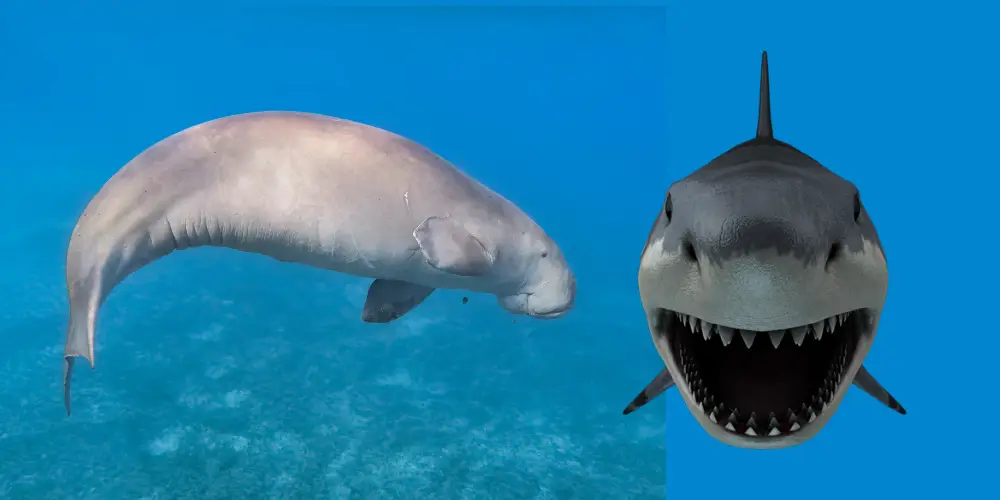“Do sharks hunt at night?” you might wonder.
Many shark species are nocturnal predators and prefer to hunt at night. Their adaptations, like enhanced vision in low light, give them an advantage in the dark. Nighttime hunting allows them to use stealth and capitalize on the behavior of nocturnal prey.
But why do they prefer the moonlit waves over the sunlit ones?
Dive into this article to uncover the mysteries of sharks’ nocturnal escapades and discover what makes the nighttime appealing to these apex predators.
Key Takeaways
- Many shark species are nocturnal predators, hunting primarily at night.
- Sharks possess specialized sensory features, like enhanced vision, for nighttime hunting.
- The Great White Shark uses ambush tactics in the dark for a surprise attack.
- Whitetip Reef, Swell, Horn, Hammerhead, Sand Tiger, Night, and Great White Sharks are notable nighttime hunters.
- Nighttime hunting offers sharks advantages like stealth and reduced competition.
- Scientific studies support sharks’ nocturnal habits, including tracking and sensory research.
- While many sharks hunt at night, they are active and feed during the day.
- Human activities in the ocean at night can intersect with sharks’ hunting patterns.
- Safety measures, like avoiding known feeding areas and limiting excessive movement, can prevent unwanted shark encounters.
- Sharks play a crucial role in maintaining the balance of marine ecosystems, and understanding their behavior is vital to coexistence and conservation.
Sharks as Nocturnal Predators

The vast and mysterious ocean transforms as day turns to night. As the sun sets, different creatures come alive, and among the most formidable are sharks.
Having roamed the oceans for over 400 million years, these ancient predators have developed unique adaptations that make them especially adept at nighttime hunting.
Being nocturnal predators doesn’t merely mean being active at night; it signifies a whole set of behaviors optimized for the dark.
The term “nocturnal” might conjure images of owls or bats in the terrestrial world, but sharks are the epitome of nighttime hunters in the aquatic realm.
Their keen senses, especially their lateral line system, allow them to detect even the slightest movements in the water, giving them a significant advantage in the dimly lit ocean.
Many species of sharks have eyes adapted to low-light conditions. Their retinas possess a high concentration of rod cells, which are sensitive to light and movement.
This enables them to see in the murkiness of the deep and during the night.
This visual adaptation, combined with their acute sense of smell and ability to detect electrical fields, makes them unparalleled nighttime hunters.
Furthermore, the nocturnal behavior of sharks is also influenced by their prey.
Many smaller fish and marine creatures are more active at night, feeding or migrating.
Recognizing this pattern, sharks have evolved their hunting schedules to align with the activity of their prey, ensuring a higher success rate.
In essence, the nighttime ocean is like a grand stage, and sharks are the stars, playing their roles as dominant nocturnal predators with precision and skill.
Types of Sharks that Hunt at Night

Several shark species exhibit nocturnal hunting behaviors, each employing unique strategies and adaptations.
- Great White Shark: Utilizing the cover of darkness, it approaches prey stealthily from below, leveraging the silhouetting effect caused by the moon or starlight.
- Whitetip Reef Shark: Active at night, it navigates coral reefs adeptly, hunting octopus, crustaceans, and bony fish using the element of surprise.
- Swell Shark: A nocturnal predator of the Pacific, it prefers bottom-dwelling prey like crustaceans and small fish and can expand its body as a defense mechanism.
- Horn Shark: This slow-moving, nocturnal predator uses its powerful jaws to feed hard-shelled prey like crustaceans, sea urchins, and small fish at night.
- Hammerhead Shark: Its uniquely shaped head offers a wide field of vision for nighttime hunting, often preying on stingrays, using their heads to pin them down.
- Sand Tiger Sharks: With the ability to hover in the water, they prowl the seabed at night for fish, squid, and smaller sharks despite their placid nature.
- Night Shark: True to its name, it is adapted to low light conditions, feeding mainly on small fish and squid in the dimly lit waters of the Atlantic Ocean.
Each of these species showcases the diversity and adaptability of marine life, emphasizing the importance of understanding and preserving the ocean’s wonders and inhabitants.
Advantages of Nighttime Hunting

Many sharks opt to hunt at night due to several strategic advantages that optimize their hunting success.
- Element of Surprise: Nighttime hunting allows sharks, like the Great White, to approach prey stealthily due to reduced visibility, utilizing ambush tactics effectively as prey often realize the predator’s presence too late.
- Sensory Superiority: Sharks’ sensory adaptations, such as eyes rich in rod cells, enable them to detect minimal light and sense vibrations and electrical fields in water, giving them an advantage in low light conditions where visual cues are limited.
- Prey Vulnerability: At night, many marine species exhibit behaviors that make them easier targets for sharks, as some become more active or are resting, and may be less alert during activities like spawning.
- Reduced Competition: Nighttime hunting means less competition from other predators not adapted to nocturnal hunting, allowing sharks access to a larger share of available prey.
- Energy Efficiency: Cooler nighttime waters can be more energy-efficient for sharks, potentially reducing their metabolic rates and allowing them to expend less energy while hunting.
- Camouflage and Environment: The unique nighttime oceanic environment, including moonlight, shifting shadows, and bioluminescence, can be used by sharks for camouflage or to attract prey.
The distinct conditions of nighttime offer various unique advantages, showcasing sharks’ adaptability and skill as apex predators by exploiting these conditions optimally.
Scientific Studies and Evidence
The nocturnal hunting habits of sharks aren’t just based on anecdotal observations; they’re backed by rigorous scientific research and evidence.
Over the years, marine biologists and researchers have delved deep into understanding these magnificent creatures’ behaviors, especially at night.
- Tracking and Telemetry Studies: Scientists use modern technology to tag and monitor sharks’ real-time movements. For example, tracking data from Great White Sharks has shown distinct patterns of Great White Sharks making hunting dives at night.
- Stomach Content Analysis: Examining stomach contents has indicated nighttime feeding in certain shark species due to the presence of primarily nocturnal prey..
- Behavioral Observations: Underwater cameras and ROVs have enabled the observation of sharks’ nocturnal activities, including hunting and feeding, offering insights into their nighttime habits.
- Sensory Research: Studies focusing on the sensory biology of sharks have shed light on their nighttime hunting adaptations. Research on sharks’ eyes has revealed the presence of a high concentration of rod cells, which are sensitive to low light conditions, confirming their ability to see in the dark.
- Environmental and Ecological Studies: Research indicates that environmental factors like moon phases can influence sharks’ behavior, potentially making them more active during specific phases favorable for hunting.
- Interaction with Prey: Observational studies on sharks’ prey provide insights into sharks’ nocturnal hunting strategies by understanding the behaviors and patterns of prey species.
This collective scientific research has comprehensively understood sharks’ nighttime hunting habits.
It underscores the need for ongoing research for conservation and to facilitate coexistence with humans.
Real-Life Examples
SAMPLA crew members witnessed a unique night-time predation of a white shark on a seal near Seal Island during a 24-hour seal survey. This thrilling experience unfolded as the crew anchored near Mossel Bay, observing the failed predation of a juvenile seal and later a possible successful one by a white shark in the darkness of the night. Witnessing this behavior was an unforgettable experience for the SAMPLA team aboard the Cheetah.”
-Ocean research
Comparison to Daytime Feeding

Sharks are versatile creatures, and while many species have adapted to hunting under cover of darkness, they are not restricted to nocturnal feeding.
Let’s dive deeper into the world of sharks and see how their daytime feeding habits compare to their nighttime escapades.
Daytime Feeding Habits
During the day, the ocean is a bustling hub of activity. The sunlight illuminates the vast waters, making prey more visible.
Some shark species take advantage of this and actively hunt during daylight hours.
For instance, the blacktip reef shark is often seen patrolling coral reefs during the day, searching for fish and cephalopods.
Factors Influencing Daytime Hunting
Several factors can influence a shark’s decision to hunt during the day:
- Prey Availability: Some prey species are more active and abundant during daylight hours, making them easier targets for hungry sharks.
- Environmental Conditions: In areas with clear waters, the visibility during the day can be advantageous for sharks to spot and chase their prey.
- Competition: If a particular area is densely populated with predators, sharks might hunt during the day to avoid nighttime competition.
Night vs. Day: A Comparative Glance
While nighttime hunting offers the advantage of stealth, daytime hunting provides sharks with better visibility.
However, the increased light also means prey can spot the approaching predator more easily, making the hunt a thrilling game of strategy and speed.
The clock does not strictly bind sharks regarding feeding. Their hunting habits, whether during the day or night, are shaped by biological needs, environmental factors, and prey behavior.
Interaction with Humans

The ocean, a vast expanse of mystery and wonder, is a shared space between sharks and humans.
Understanding how sharks behave, especially at night, becomes crucial for ensuring safety and fostering coexistence as we venture into their recreation, work, or exploration domain.
Human Activities in the Ocean at Night
Nighttime activities in the ocean, such as night diving, fishing, or even late-night swims, have grown in popularity.
The allure of experiencing the marine world under the moonlight is undeniable. However, these activities can sometimes intersect with the hunting patterns of sharks.
Sharks’ Perception of Humans at Night
Sharks do not typically view humans as prey. However, the reduced visibility at night can lead to misidentifications.
For instance, the silhouette of a diver or swimmer might resemble that of a seal or other prey, especially if they are wearing shiny jewelry or equipment that reflects light.
Safety Measures and Precautions
- Stay Informed: Before venturing into the ocean at night, it’s essential to be aware of the shark species prevalent in the area and their behaviors.
- Avoid Known Feeding Areas: Areas where marine animals congregate, such as seal colonies or fishing spots, can attract sharks. Avoiding these zones, especially during their active feeding times, is advisable.
- Stay in Groups: Sharks are less likely to approach larger groups. If you’re diving or swimming, stay close to your companions.
- Limit Excessive Movement: Rapid or erratic movements can attract curious sharks. Try to maintain a calm and steady pace.
- Avoid Wearing Shiny Objects: Reflective jewelry or equipment can mimic the sheen of fish scales, potentially drawing sharks closer.
- Exit the Water Calmly: If you spot a shark, remain calm and slowly return to the shore or boat. Avoid making sudden movements or splashing.
Promoting Understanding and Respect
It’s essential to remember that sharks are not mindless predators out to harm humans.
Most shark encounters are cases of curiosity or mistaken identity. By understanding their behaviors and taking necessary precautions, we can safely enjoy the ocean’s beauty, day or night, and ensure that these magnificent creatures are respected and protected.
Final Thoughts

The vast, deep blue ocean is a realm of endless mysteries, and among its most captivating inhabitants are sharks.
These apex predators, with their sleek forms and razor-sharp teeth, have long been subjects of fascination and fear.
But a more nuanced picture emerges as we journeyed through their nocturnal world’s depths.
Sharks, in their myriad shapes and sizes, have evolved over millions of years to become masters of their domain.
The nighttime, with its cloak of darkness, offers them a unique playground where they employ a blend of stealth, sensory prowess, and strategy to hunt.
From the formidable Great White Shark, using the moonlit ocean as its hunting ground, to the gentle sand tiger Shark scouring the seabed for hidden treats, the nocturnal behaviors of these creatures are a testament to their adaptability and survival instincts.
But there’s a broader lesson for humans beyond the world of sharks. Understanding and respecting its inhabitants becomes paramount as we venture into the ocean.
The nighttime behaviors of sharks are not just about their hunting habits but are symbolic of the intricate balance of life in the marine ecosystem.
In wrapping up our deep dive into the world of sharks and their nocturnal escapades, one thing is clear: these magnificent creatures, adapted to the challenges of the dark, are yet another marvel of the natural world.
As we continue to explore and coexist with them, we must ensure their conservation and celebrate the wonders they bring to the ocean’s tapestry.
CHECK OUT MORE SHARK TOPICS BELOW:
REFERENCES:
- Moore, C. (2008, August 26). Shark Chronicles 025 – Night Time Hunting. Oceans Research. https://www.oceans-research.com/shark-chronicles-025-night-time-hunting/
- Night shark. (2023, August 12). In Wikipedia. https://en.wikipedia.org/wiki/Night_shark
- Whitetip reef shark. (2023, June 21). In Wikipedia. https://en.wikipedia.org/wiki/Whitetip_reef_shark
- Swell shark. (2023, February 10). In Wikipedia. https://en.wikipedia.org/wiki/Swell_shark
- Horn shark. (2023, January 15). In Wikipedia. https://en.wikipedia.org/wiki/Horn_shark
- Hammerhead shark. (2023, August 16). In Wikipedia. https://en.wikipedia.org/wiki/Hammerhead_shark
- Sand tiger shark. (2023, August 29). In Wikipedia. https://en.wikipedia.org/wiki/Sand_tiger_shark



